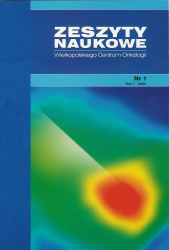Abstract
The key challenge in radiotherapy is to select the appropriate maximum doses of radiation reaching the cancer cells while minimizing the damage to healthy tissue. The success of radiotherapy in the treatment of tumor depends mainly on the total dose administered during treatment whereas the tolerance to radiation of normal tissues is a certain limitation in the selection of maximum doses. In order to avoid any adverse effects after radiotherapy, certain dose thresholds should not be exceeded. The risk of radiation damage to normal tissues increases with the total dose, the number of radiotherapy fractions and the volume of tissues that have been irradiated. Patients under 10 years of age and patients over 70 are particularly susceptible to complications.
Radiation used in radiotherapy causes damage to cellular structures responsible for basic cellular processes. X-rays collide with electrons causing ionization of molecules. These electrons lose the ability to function properly within the cell. In the course of this process, deoxyribonucleic acid (DNA - deoxyribonucleic acid) is damaged, which can cause mutations. The most susceptible to radiation damage are hematopoietic cells, endothelial cells, mucous membranes and the gastrointestinal tract. Thus, several effects can be distinguished following the contact of a living cell with ionizing radiation. The first of them can be such a big damage to the cell that it may be able to perform its functions and may be killed. The cell may also lose its ability to reproduce, although it may remain alive. The DNA code might be damaged so much that the resulting cell copies would be significantly different from the original cell. Radiation may also not cause side effects or maid have not effect on the cell at all.
References
E. Louis, S.A. Mayer, L.P. Rowland, red. wyd. pol. W. Turaj. Merritt Neurologia - tom 1-2; Wyd Edra Urban & Partner. Rok 2017
W. Łobodziec. Podstawy fizyki promieniowania jonizującego na użytek radioterapii i diagnostyki radiologicznej. Wydawnictwo Uniwersytetu Śląskiego. Rok 2016, ISBN: 9788379963881
P.Jaracz. Promieniowanie jonizujące w środowisku człowieka. Fizyka. Skutki radiologiczne. Wydawnictwo Uniwersytetu Warszawskiego. Rok 2001, ISBN: 83-235-0146-7
P.W. Lampert, R.L. Devis, Delayed effects of radiation on the human CNS-early and late delayed reactions.; Neurology, s. 912-917
Stone, Anscher, Coleman, McBride. Effects of radiation on normal tissue: consequences and mechanisms. The Lancet Oncology. Rok 2003; s. 529-536.
Bentzen, Constine, Deasy , Eisbruch , Jackson , Marks. Normal Tissue Effects in the Clinic (QUANTEC): an introduction to the scientific issues. Int J Radiat Oncol Biol Phys. Rok 2010
S.M. Bentzen. Preventing or reducing late side effects of radiation therapy: radiobiology meets molecular pathology. Nat Rev Cancer. Rok 2006; s.702-713.
J.S Haviland, M.Mannino, C.Griffin, N.Porta, M.Sydenham, J.M. Bliss, J. R. Yarnold. Late normal tissue effects in the arm and shoulder following lymphatic radiotherapy: Results from the UK START (Standardisation of Breast Radiotherapy) trials Radiother Oncol. Rok 2018 s.155-162.
Borgmann , Roper , El-Awady , Brackrock , Bigalke , Dork , Alberti , Dikomey , Dahm-Daphi. Indicators of late normal tissue response after radiotherapy for head and neck cancer: fibroblasts, lymphocytes, genetics, DNA repair, and chromosome aberrations.; Radiother Oncol. Rok 2002; s.141-152.
Sterpone , Cornetta , Padua , Mastellone , Giammarino , Testa , Tirindelli , Cozzi , Donato. DNA repair capacity and acute radiotherapy adverse effects in Italian breast cancer patients.; Mutat Res. Rok 2010; s. 43-48.
L.A. Jones,D. Scott , R.Cowan , S.A. Roberts. Abnormal radiosensitivity of lymphocytes from breast cancer patients with excessive normal tissue damage after radiotherapy: chromosome aberrations after low dose-rate irradiation.; Int J Radiat Biol. Rok 1995; s 519–528.
G.C. Barnett, C. M. L. West, A.M. Dunning, R. M. Elliott, C.E. Coles, P.D. P. Pharoah, N.G. Burnet.; Normal tissue reactions to radiotherapy.; Nat Rev Cancer. Feb; 9(2). Rok 2009; s. 134-142
S. Kirolikar, P. Prasannan, G.V. Raghuram, N.Pancholi, T.Saha, P.Tidke, P. Chaudhari, A. Shaikh, B.Rane, R.Pandey, H.Wani, N. K. Khare, S.Siddiqui, J. D’souza, R.Prasad, S. Shinde, S.Parab, N. K. Nair, K. Pal , I. Mittra. ;Prevention of radiation-induced bystander effects by agents that inactivate cell-free chromatin released from irradiated dying cells.; Cell Death & Diseasevolume 9, Artykuł nr 1142. Rok 2018
K.Ariyoshi, T.Miura, K. Kasai, Y.Fujishima, A.Nakata, M. Yoshida. Radiation-Induced Bystander Effect is Mediated by Mitochondrial DNA in Exosome-Like Vesicles.; Scientific Reports 9, Artykuł nr 9103. Rok 2019, s. 1-14
